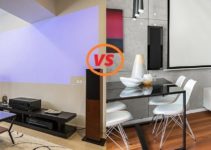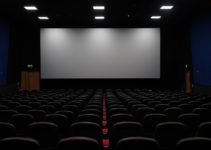Many people wonder: how many lumens do you need to project in daylight? To make your projector images successfully display in daylight, you need a projector lamp brightness of 2,500 lumens at a minimum. If you have to project in brightly lit environments, even in sunlight, you need at least 4000 lumens for your projector.
What is “lumens”?
If you are interested and knowledgeable about the parameters of a projector, you will certainly notice that each projector will have different parameters, including lumens.
Each type of projector used in different environments will have different lumens specifications. As such, one question arises: What is lumens?
Lumens are the unit of measurement of the brightness of light, almost equivalent to the Lux unit. Wikipedia defined lumens as a measure of the total amount of visible light in a given number of beams or angles or from several sources.
It is a photometric quantity that indicates the radiated power of the light beam emitted by a point light source. The unit of luminous flux in SI, CGS units is lumen, denoted by LM.
What is the relationship between lumens and brightness?

Between lumens and the brightness, there is a close relationship to creating a successful display in terms of images. To put it more clearly, when the projector’s lumens and environmental lumens are balanced, the viewers feel most comfortable.
They don’t feel much eye pain, discomfort, or experience less negative eye effects. Usually, lumens and environmental brightness are proportional to each other.
The importance of lumens and brightness for an outdoor projection?
To get sharp, high-quality images with moderate brightness and a balance between the environment and the lighting of the target image, digital film projector manufacturers need to calculate and deliver different projectors that are used for different purposes.
If you cannot balance the above two factors, you will most likely experience bad eyes and brightness issues, reducing the enjoyment of watching. Here is some useful information on the importance of lumens and brightness as well as some caveats to consider.
Relationship and harmony between brightness and lumens
If the projector has many lumens, the light received after projection will have the same lumens ratio.
Sunlight has very high brightness, this figure is calculated at around 12,000 lumens. To make the projector display its images in daylight, your projector must be as bright as possible, then the resulting image will look better, sharper, and more harmonious even in bright light around.
In contrast, projectors with low light (low lumens) often prefer dark or dim environments to ensure the clearest images.
Parameter considerations
You need to consider applying in your situation. Answer 2 questions about what you use the projector for, where to locate the projector, then you will find the right projector.
To explain more closely, a projector’s intended use will determine the number of lumens on it. Typically, 2,500 – 3,000 lumens or more is the best minimum lumens for projectors in which environmental light is present.
However, in some cases, higher brightness than usual is required to provide a good viewing experience. In some games, for example, they need to use higher brightness than in other cases.
Consider the brightness of the daytime projection environment
This is also important because it is the same day, but the intensity of the light at different times is different. Besides, we should consider whether the projector is indoors or outdoors, how much of the light falls in it, and see what lighting aids can be used.
Consider lumens from the supported light sources
Not everywhere are available light sources (or sources emitting lumens) to support the projection process. This condition is only met in places with dense lighting, with a variety of colors, capacities, and lumens ratings, for example, in movie theaters.
However, if there are no such ideal conditions, it is advisable to research and choose a projector that best suits the projection environment to ensure a good experience during projection.
How many lumens do you need to project in daylight?
A question asked: how many lumens for outdoor projection? There is no completely accurate data to calculate the number of lumens needed in an environment because there are many light sources as well as light-blocking agents.
However, studies conducted in the past have given numbers with approximate accuracy. They calculate based on the formula proven by science and give the most ideal answer. So, how many lumens is daylight?
Minimum lumens for projector in daylight is calculated to be 2500 lumens, including 2 cases outdoors and in the room with light doors. This lowest level is generally suitable for environments with poor daylight, such as overcast weather or rooms with not too bright light.
Minimum lumens for the outdoor projector is recommended at about 2,500-3,000 lumens because outdoor light is usually more intense, so the projector’s lumens need to be higher for compatibility.
How many lumens do you need to project in sunlight?
It is well known that the sun is considered to be a natural light source with the strongest lumens intensity of natural light agents. The number of lumens calculated directly in the sun is up to 12,000 lumens so, according to the ratio of the projector’s lumens to the ambient brightness.
So, how many lumens is sunlight? Lumens for a projector in sunlight will also be a pretty high number. According to data studied and recorded by scientists, this number should not be lower than 4,000 lumens.
The ideal distance to deliver a great experience of image quality is around 4,000 – 5,000 lumens, and depending on the intensity of the sun’s light, the exact number required may be changed.
Therefore, choosing a projector with a lumens rating between 4,000 – 5,000 is the most reasonable answer to the question above.
What to do if the projector does not have the ideal lumens rating while projecting outdoors?
The solutions below are only applicable for projectors with the recommended lumens slightly lower or higher than the ambient magnitude. If the difference is too high, those solutions will have little or no effect.
At that time, the only possible way would be to replace another projector with a compatible number of lumens.
The lumens is lower than 2,500
As we all know, the minimum lumens for an outdoor projector that an outdoor environment needs is 2,500 lumens. Therefore, it is very important to choose a projector with the right parameters to ensure the right brightness.
However, in the case of force majeure, without having a projector with the right parameters, we need to flexibly create the right environment for the projector to deliver the best image, providing a good experience for the viewers.
The brightness of the environment where we need to project is proportional to the number of lumens needed for each camcorder, so when the number of lumens is lacking to ensure the ideal projection environment, we need to reduce the intensity of the light outside of the projection environment.
The first solution is to choose timelines with mild weather and shady locations to balance the brightness between the environment and the projector.
If the first solution is not enough to solve the problem, use additional light shields or tarpaulins to block the light emitted by the light sources. The light source in this environment is mainly sunlight.
The lumens are higher than 4,000
Contrary to the above case, when the projector’s lumens are too high compared to the ambient brightness (over sunlight lumens), it creates an imbalance in light. We must regain this balance by creating the ideal environment to accommodate the projector’s light output.
Usually, this case only happens when the projector’s lumens are too large compared to normal, then it will cause eye pain and glare for viewers. If not, then you will feel the bright screen is also an advantage.
The only way for this unbalanced case is to increase the brightness of the projection environment to accommodate the projector’s lumens. As a result, the brightness is balanced and the image quality is displayed at its best.
However, increasing the brightness of the environment is not easy either. It will need a huge source of artificial light because outdoor spaces need a lot of lumens to increase the brightness.
In this case, you should choose the moment when the project has the strongest natural light, using bulbs with high lumens to increase the brightness. A small tip is to localize the projection space with light shields.
This may sound a bit ridiculous, but it helps the lumens emitted from the bulb to maximize the effect of lighting in a certain space without being wasted outside.
Conclusion
In short, a projector’s lumens and environmental brightness are closely related to balancing image quality when projected under daylight even in sunlight.
A projector with a rating of 2,500 – 3,000 lumens is an ideal condition that is recommended for a projector in daylight, and a projector with a rating of 4,000 or higher is recommended as a lumens for projector in sunlight.
Also, to answer the question of how many lumens for outdoor projector, we need to carefully consider and calculate the light and shading factors to find the most suitable outdoor projector.






